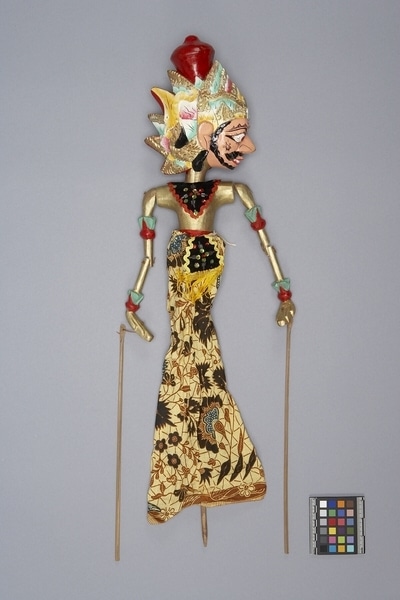Rod Puppet Item Number: Ib400 a-c from the MOA: University of British Columbia


Description
Three-dimensional male humanoid puppet: large head (part b) fits into body with skirt (part a), and a control rod (part c) with a long shaft that passes through the body and fits into the neck of the figure's head. The body has jointed arms, each with a long controlling rod attached. Pale pink face positioned forward with bulging white eyes (red irises), large nose, red lips, and white teeth. Beard, large moustache, deeply furrowed brow, and other facial details in black. Large crown (mahkota) headdress in red, gold, green, and white. Garuda Mungkur (short tongue) in yellow. Two badong and single kendit. Medium-sized body; neck and torso gold. Arms with pair of green and red ornaments at bicep and wrist. Hands held flat and bent up at wrist. Black chest covering with red trim, beads and sequins. Black apron with yellow waistband and yellow trim, beads, sequins, and long yellow fringe at bottom. Long brown, blue on beige batik skirt.
History Of Use
Javanese puppetry as an art form probably developed by the 11th century. Wayang golek puppets of western Java appeared during the 16th century. Originally the plays depicted Javanese mythology, but after the Indian conquest of Java the Hindu epics, Ramayana and Mahabharata, were incorporated into the cycles, which comprise about 200 plays. A dalang (puppet master) performs the plays to celebrate important occasions, usually in three acts, with vocal and instrumental accompaniment. Typically they serve a moral and religious purpose, and more recently, one of political commentary. This puppet may play the role of a king, or other exalted noble. It may be an extreme character variation, or a disguise, but this is doubtful.
Cultural Context
Theatrical performance.
Iconographic Meaning
Each puppet is characterized by its wanda, a Javanese word which describes the specific mixture of elements of size, form, colour, ornamentation and carving. Pink face, large facial features, and red irises indicate aggressiveness, and are not refined. Batik, position of hands, and particularly headdress suggest high nobility, if not virtue. Crown headdress found only on kings or gods. Character not identified; certainly a king of somewhat evil disposition.
Item History
- Made in Java, Indonesia
- Owned by Donald Bone before January 4, 1980
- Received from Donald Bone (Seller) and Museum of Anthropology Donations Fund (Funding source) on January 4, 1980
What
- Name
- Rod Puppet
- Identification Number
- Ib400 a-c
- Type of Item
- puppet
- Material
- paint, cotton fibre, wood and fibre
- Manufacturing Technique
- sewn, painted, woven, tied and carved
- Part A
- height 5.5 cm, width 19.0 cm, depth 6.5 cm
- Part B
- height 22.0 cm, width 9.5 cm, depth 16.0 cm
- Part C
- height 38.5 cm, width 2.5 cm, depth 1.3 cm
Who
- Culture
- Sundanese
- Previous Owner
- Donald Bone
- Received from
- Donald Bone (Seller) and Museum of Anthropology Donations Fund (Funding source)
Where
- Holding Institution
- MOA: University of British Columbia
- Made in
- Java, Indonesia
When
- Ownership Date
- before January 4, 1980
- Acquisition Date
- on January 4, 1980
Other
- Condition
- fair
- Current Location
- Case 61
- Accession Number
- 0586/0020 a-c